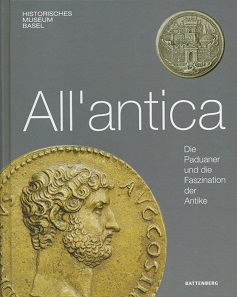Written by Ursula Kampmann
Translated by Leonie Schulze
January 10, 2019 – There are only a few books that I already use despite them being placed on the shelf of works that have yet to be presented in our book reviews section. “All’antica” – Die Paduaner und die Faszination der Antike” by the Basel Historical Museum is one of them. It is an extensive catalog that includes a detailed introduction to a field which has been disregarded by numismatics for far too long: the Paduans – beautiful new creations of the early modern period based on ancient models which, for the longest time, were not sold as Renaissance medals but as counterfeits.
Michael Matzke (Ed.), All’antica. Die Paduaner und die Faszination der Antike. Schriftenreihe der Numismatischen Gesellschaft Speyer 55. Battenberg Gietl Verlag, Regenstauf 2018. 376 pp., fully illustrated in color. Hardcover. 20 x 24.6 cm. ISBN: 978-3-86646-166-6. 39.90 euros.
Michael Matzke, the curator of the unique coin collection that is kept at the Basel Historical Museum, is responsible for the idea behind the book. In 2015, he inaugurated a fascinating exhibition titled “„Gefälschte Antike? Die Paduaner und die Faszination der Antike“. He came across copies which were superior to the Roman originals in terms of engraving and technical execution. He noticed that the Paduans by Giovanni da Cavino were in turn also imitated, which implied that there were in fact various hubs and masters who produced Paduan coins and medals.
That was probably what inspired him to recatalog the collection of so-called “Paduans” owned by the Basel Historical Museum. And what an urgent endeavor that was! Not only because research in the field is in desperate need of such a catalog in order to analyze whether the coins published in earlier numismatic catalogs, which do not have a Roman equivalent, were inventions of the respective author or whether they were actually part of the collection. Paduans and their imitations have repeatedly found their way out of time-honored collections and onto the market. Most of the time, they are subsumed under one lot and sold as imitations. But those pieces deserve more than that! Because the craftsmanship required to produce these early modern Roman-style medals is truly remarkable.
Michael Matzke and several of his colleagues set out to retrieve the honor of those medals. Lucas Burkart’s introduction sets the historical stage these pieces of art could develop on. “The Renaissance as a culture of imitation, appropriation, and new creation” – the title itself already bears this message.
Jürgen Kraut looks at the technological know-how that was applied in the creation of the pieces. Anyone who is interested in minting technology absolutely must read this section.
Michael Schaffner adds a new acknowledgement of Ludovic Demoulin de Rochefort, personal physician of the Savoyan dukes, who sold his medals to Basilius Amerbach in 1576. This is how a large share of the pieces initially became part of the collection.
Michael Matzke himself provides an introduction about the Paduans.
The catalog that follows is the part of the work, which will probably be used most. It is subdivided according to engravers and themes:
- Giovanni da Cavino (1500-1570) and his workshop
- Medals in honor of Caesar and the Roman emperors by unknown artists
- Valerio Belli (around 1468-1546)
- Workshop and successors of Valerio Belli
- Giovanni Boldù (+ before 1477) and his surroundings
- Gian Giacomo Bonzagni, referred to as Parmigiano (around 1507-1565)
- Alessandro Cesati (active 1538-1561)
- Vittore Gambello (around 1450/55-1537)
- All’antica medals of various artists
- Miscellaneous
The names themselves are already conclusive: until now, Parmigiano has probably not made anyone think of the Paduans.
The catalog is coherently structured. Actual size colored illustrations, description of the piece held in Basel, including its provenance and additional comments. Please note, this is not a complete catalog of all all’antica medals, but one that lists all those pieces found at the Basel Historical Museum today. However, due to the institution’s collection history, it may well be one of the world’s largest collections of this field – and surely one of the most well-reviewed.
All those who are interested in the Renaissance must own a copy of this catalog. Of course, it should also be purchased by those who want to ensure that they don’t purchase a Paduan instead of a Roman sestertius. Although, if you pay attention to the incredible craftsmanship that was required to make these medals, you might just be inclined to pay more money for a Paduan than you were before. After all, Renaissance medals are some of the most expensive numismatic objects on the market today. Who knows, perhaps the beautiful Paduans will soon be more expensive than their Roman models.
You can purchase the book on the website of the Gietl-Verlag.
Michael Matzke explained how the images on the so-called Paduans came about and who was responsible for their design in a wonderful article titled “Herculus in the backyard”.
Of course, CoinsWeekly has also published detailed articles about some of the museum’s important collections, the bequest of Erasmus of Rotterdam and the Basilius Amerbach Collection.
You can take a look at the permanent exhibition here.




